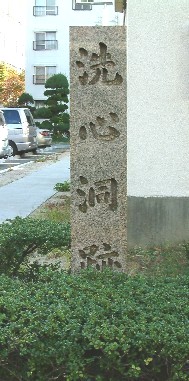Museum Q&A
Please click on the Q & you can get A.
Senpukan was designated as important cultural property in 1956. The Senpukan was built in 1870 by Thomas Waters. It was originally used as a reception hall by the Mint; today, however, it is the property of the City of Osaka.


Here OSHIO Heihachiro, a former Temma Yoriki resided, opened a private school named "Senshindo" and taught various learning.

The gate facing the Yodo River was once the front gate. It still looks much as it did in the early years of Meiji Era (1868-1912) .

The pair of westernized gaslights located just inside the old Front Gate are the oldest in Japan and still remain in good condition today.

Born in 1828 in Kyoto. He began to learn metalworking at the age of twelve and went to Edo (Tokyo) at the age of twenty-five and devoted himself to studies. He became craftsman for the Imperial Household. During the early Meiji era beautiful coinage was created and designed by him. He was specifically responsible for designing and die making.

Born in Yamaguchi prefecture. He went abroad to study together with four far-sighted noblemen from Choshu (currently Yamaguchi prefecture) such as INOUE Kaoru (later Finance Minister) and ITO Hirobumi (later the first Prime Minister). He began to work for the Mint in 1870 and became the master of the Mint. He worked for the Mint for over 11 years, the second longest term of office among Mint masters. In 1883 his suggestion "Let's admire the beauty of cherry blossoms together with Osaka citizens" triggered the opening of "the Cherry Blossom Viewing through its tunnel".

Born in Gifu prefecture. He studied chemistry inspired by a visit of the American fleet off the Uraga shore; Commodore Perry requested opening Japan to trade with USA. His study expanded chemistry to photographing technique and firework production. He worked for stipulation on New Coinage Law and founding of the Mint and was promoted to the first master of refining and analysis of the Mint.

Born in Yamaguchi prefecture. He had been working for the Mint for 43 years since he joined the Mint in 1870: real Mint staff. He contributed much to the stipulation of Coinage Law and expansion of the coinage production capacity as well as electrification of energy during his terms of general-director's office. His bronze statue was erected to praise his outstanding achievements inside the old front gate in the Mint premises.

In April 1964, stone Senryu monument of Keikabo was erected. It reads "In Osaka, Home of Flowers is here, Cherry Blossom Viewing in the Mint". He was a leading Senryu poet as well as a famous learner of culture of the Edo period. His monument was also situated in the precincts of Sanno shrine in Wakayama prefecture.
"Kochosen" is the series of 12 copper coins issued in the 250-year period starting in 708, when Japan's first coin, the Wadokaihou, was issued.
The Court aimed at spreading the use of this series throughout the nation, which did not go smoothly.
After the series of Kochosen, coins were not to be issued for the next 600 years.
Actual coins from those days are exhibited on the third floor of the Mint Museum.
While coins were not issued in Japan, good-quality copper coins, known as "Torai-sen" in Japanese, were introduced from China.
In the capital, coins were still used for commercial transactions.
These coins were very popular, utilized not only in Japan but also in East Asia.
As trade prospered, the demand for money increased and a number of coins were imported from China.
The imported coins circulated in Japan.
On the third floor of this Mint Museum, you can see Sung coins in those days.






